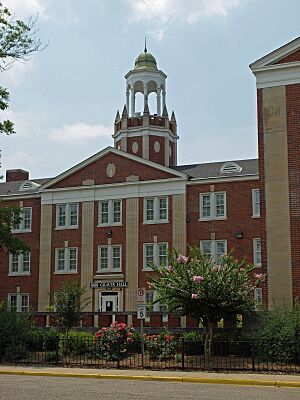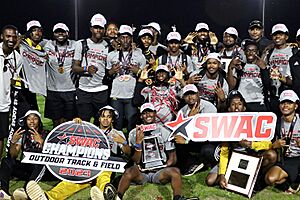Alabama State University facts for kids
 |
|
|
Former name
|
Lincoln Normal School of Marion (1867–1887) Normal School for Colored Students (1887–1929) State Teachers College (1929–1948) Alabama State College for Negroes (1948–1954) Alabama State College (1954–1969) |
|---|---|
| Type | Public historically black university |
| Established | 1867 |
|
Academic affiliations
|
TMCF |
| Endowment | $125 million (2024) |
| President | Quinton T. Ross Jr. |
| Provost | Carl Pettis |
| Students | 5,475 |
| Undergraduates | 5,116 |
| Location |
,
,
United States
|
| Campus | Urban, 172-acres |
| Newspaper | The Hornet Tribune |
| Colors | Black and Old gold |
| Nickname | Hornets and Lady Hornets |
|
Sporting affiliations
|
NCAA Division I FCS – SWAC |
 |
|
Alabama State University (often called ASU, Bama State, or Alabama State) is a public university in Montgomery, Alabama. It is known as a historically Black university. This means it was founded to provide higher education for African American students during a time when they faced discrimination.
ASU was started in 1867, right after the Reconstruction era in the United States. It was one of many "normal schools" created to train teachers. These schools helped prepare people to teach in the growing public school system. ASU was one of 23 such schools set up to train African American teachers. Over time, many of these schools grew into colleges and then universities. ASU is also part of the Thurgood Marshall College Fund, which supports public historically Black colleges and universities.
Alabama State's sports teams are called the Hornets. They play in NCAA Division I and are part of the Southwestern Athletic Conference (SWAC).
Contents
History of Alabama State University
Alabama State University began in 1867 as the Lincoln Normal School of Marion in Marion. In 1874, the state of Alabama officially took over the school. This made it America's first state-supported school for Black students. It started as a "teachers' college," focusing on training teachers.
William Burns Paterson became the second president in 1878. He is seen as a founder of ASU. He led the school for 37 years and helped move it from Marion to Montgomery in 1887.
When the university opened in Montgomery in 1887, its name had to change. It became the Normal School for Colored Students. The campus was chosen in 1889, and buildings were prepared.
Over the years, the school grew. In 1928, it became a full four-year college. Its name changed several times:
- 1929: State Teachers College
- 1948: Alabama State College for Negroes
- 1954: Alabama State College
- 1969: Alabama State University
In 1995, a court decision called Knight vs. Alabama helped ASU grow even more. It allowed the university to offer new study programs, scholarships, and build new facilities.
WVAS-FM, the university's radio station, started broadcasting in 1984. It now reaches many counties and can be heard online around the world. In the early 1990s, ASU also helped create WAPR-FM (Alabama Public Radio), which reaches a wide area in central Alabama.
In 2021, ASU received a large grant of $24.7 million from the U.S. Department of Education. This money helps students from Montgomery Public Schools get ready for college. It was the biggest grant in the university's history.
Leaders of the University
- 1874–1878: George N. Card
- 1878–1915: William Burns Paterson
- 1915–1920: John William Beverly
- 1920–1925: George Washington Trenholm
- 1925–1961: Harper Councill Trenholm
- 1962–1981: Levi Watkins Sr.
- 1981–1983: Robert L. Randolph
- 1983–1991: Leon Howard
- 1991–1994: Clifford C. Baker
- 1994–2000: William Hamilton Harris
- 2001–2008: Joe A. Lee
- 2008–2012: William Hamilton Harris
- 2012: Joseph H. Silver Sr.
- 2014–2016: Gwendolyn Boyd
- 2017–present: Quinton T. Ross Jr.
What Students Can Study
ASU has eight main colleges and schools where students can earn degrees:
- College of Business Administration
- College of Education
- College of Health Sciences
- College of Liberal Arts & Social Sciences
- College of Science, Mathematics & Technology
- College of Visual & Performing Arts
- Division of Aerospace Studies
- Continuing Education
Students at Alabama State can choose from 47 different degree programs. These include 31 bachelor's degrees, 11 master's degrees, and 3 doctoral degrees. There's also an Honors Program for students who do very well in their studies.
ASU has a special partnership with Auburn University and the University of Alabama at Birmingham (UAB). This allows ASU students interested in engineering to easily transfer to Auburn or UAB. They can earn a science degree from ASU and an engineering degree from Auburn or UAB in about five years.
Alabama State is officially approved by the Commission on Colleges of the Southern Association of Colleges and Schools. This means its programs meet high quality standards.
Research Centers
ASU has several centers where important research is done:
- Center for Nanobiotechnology Research
- Center for Leadership & Public Policy
- East Asian Institute for Business Research and Culture
- Urban Economic Research Development Center
- National Center for the Study of Civil Rights and African-American Culture
Campus Life
ASU's campus is in the city and covers 172 acres. It has a mix of older brick buildings and modern ones. Key places on campus include:
- The ASU Acadome: A large 7,400-seat building used for academics and sports.
- The Levi Watkins Learning Center: A five-story library with over 267,000 books.
- The John L. Buskey Health Sciences Center: An 80,000 square foot building with classrooms, labs, and clinics for health studies.
- WVAS-FM 90.7: The university's public radio station.
Student Life
| Race and ethnicity | Total | ||
|---|---|---|---|
| Black | 91% |
|
|
| International student | 2% |
|
|
| Unknown | 2% |
|
|
| White | 2% |
|
|
| Hispanic | 1% |
|
|
| Two or more races | 1% |
|
|
| Economic diversity | |||
| Low-income | 71% |
|
|
| Affluent | 29% |
|
|
Alabama State University has almost 6,000 students. They come from over 40 different states and more than 20 countries. About 40% of the students are from outside Alabama.
Sports Teams
The Alabama State University sports department has many teams for both men and women. Men's sports include football, baseball, basketball, golf, tennis, track, and cheerleading. Women's sports include basketball, soccer, softball, bowling, tennis, track, volleyball, golf, and cheerleading.
The teams play in National Collegiate Athletic Association (NCAA) Division I. For football, they are in the Football Championship Subdivision (FCS). They joined the Southwestern Athletic Conference (SWAC) in 1982. The university's colors are black and old gold, and their teams are called the Hornets.
The Mighty Marching Hornets
Alabama State's marching band is famous and known as "The Mighty Marching Hornets." The band has been featured in a documentary series called Bama State Style. In 2016, they appeared in the movie Billy Lynn's Long Halftime Walk. A video of their 2012 halftime show at the Magic City Classic has been watched over three million times online. The band also performed in the 2019 Rose Parade in California. In 2023, Alabama State was the first historically Black university to host the annual Honda Battle of the Bands.
The band has a special dance team called "The Sensational Stingettes," which started in 1977. They have appeared in music videos and live performances with famous artists. They were also featured in Beyonce's Netflix special "HΘMΣCΘMING: A film by Beyonce".
Another dance team is "The Honey-Beez," which started in 2004. This team is made up of plus-size young women. In 2017, they were on America's Got Talent, and in 2020, they had their own show on Snapchat.
The Bama State Collegians
The Bama State Collegians is a big band jazz orchestra at Alabama State University. In the 1930s, the famous jazz trumpeter Erskine Hawkins led this group. He is in both the Alabama Jazz Hall of Fame and the Alabama Music Hall of Fame. After moving to New York City, the Collegians, led by Hawkins, became the Erskine Hawkins Orchestra. They created many hit songs, including "Tuxedo Junction" and "After Hours". "Tuxedo Junction" became a very popular song during World War II.
Student Publications
Students at ASU have two main publications:
- The Hornet Tribune: The student newspaper.
- The Hornet: The student yearbook.
Other Interesting Facts
- WVAS 90.7 FM Radio: Alabama State's radio station.
- Magic City Classic: One of the biggest events for historically Black colleges and universities, featuring a football game.
- Turkey Day Classic: One of the oldest football classics for historically Black colleges and universities.
Famous People Who Attended or Taught at ASU
| Name | Class year | Notability | |
|---|---|---|---|
| 2 Chainz | American rapper, played basketball for two seasons while attending | ||
| Ralph Abernathy | 1950 | civil rights leader and minister | |
| Reggie Barlow | 1996 | former professional football player and coach | |
| Brad Baxter | former football running back for the New York Jets | ||
| Clarence Carter | 1960 | soul singer and musician | |
| London "Deelishis" Charles | winner of reality show Flavor of Love 2 | ||
| Michael Coe | 2007 | NFL defensive back | |
| James Daniel | 1974 | football coach for the Pittsburgh Steelers | |
| Steven Daniel | 1993 | actor and comedian | |
| Thomas Figures | 1966 | first African American assistant district attorney and assistant United States Attorney | |
| Fred Gray | attorney who represented Rosa Parks during the Montgomery bus boycott | ||
| Erskine Hawkins | jazz musician, composer of "Tuxedo Junction" | ||
| Dorothy E. Hayes | early Black graphic designer, educator, and curator | ||
| Tarvaris Jackson | 2006 | professional football player, quarterback for the Seattle Seahawks | |
| Terren Jones | 2012 | NFL offensive lineman | |
| Lil Yachty | vocalist | ||
| Kevin Loder | 1981 | former NBA player | |
| Manny Martin | former NFL defensive back for the Buffalo Bills | ||
| Tangi Miller | 1993 | actress from Felicity | |
| Travis Pearson | former Arena Football League player | ||
| Eddie Robinson | former linebacker in the NFL, played in Super Bowl XXXIV | ||
| Quinton Ross | member of the Alabama Senate | ||
| Eugene Sawyer | 1956 | politician and businessman, Mayor of Chicago | |
| Dr. Fred Shuttlesworth | civil rights leader and minister | ||
| Rickey Smiley | 1992 | comedian and actor | |
| Felix Stallings, Jr. | electronica artist, producer, and DJ Felix da housecat | ||
| Jessie Tompkins | 1998 | former athlete in track and field; challenged race-based scholarships | |
| Fred Wesley | jazz and funk trombonist, known for his work with James Brown | ||
| Jesse White | 37th Secretary of State of Illinois | ||
| Doug Williams | 1995 | comedian and actor | |
| Marcus Winn | former linebacker for the Edmonton Eskimos and the Winnipeg Blue Bombers |
Notable Faculty
| Name | Department | Notability | Reference |
|---|---|---|---|
| Harold Franklin | First black student at Auburn University | ||
| Alvin Holmes | alumnus and member of the Alabama State Legislature | ||
| Jo Ann Robinson | leader in the Montgomery, Alabama Women's Political Council and the Montgomery bus boycott | ||
| Tonea Stewart | actress, playwright, and Dean of the College of Visual and Performing Arts | ||
| Josephine Turpin Washington | early writer on civil rights topics | ||
| Sheyann Webb-Christburg | civil rights activist, author of Selma Lord Selma! |




